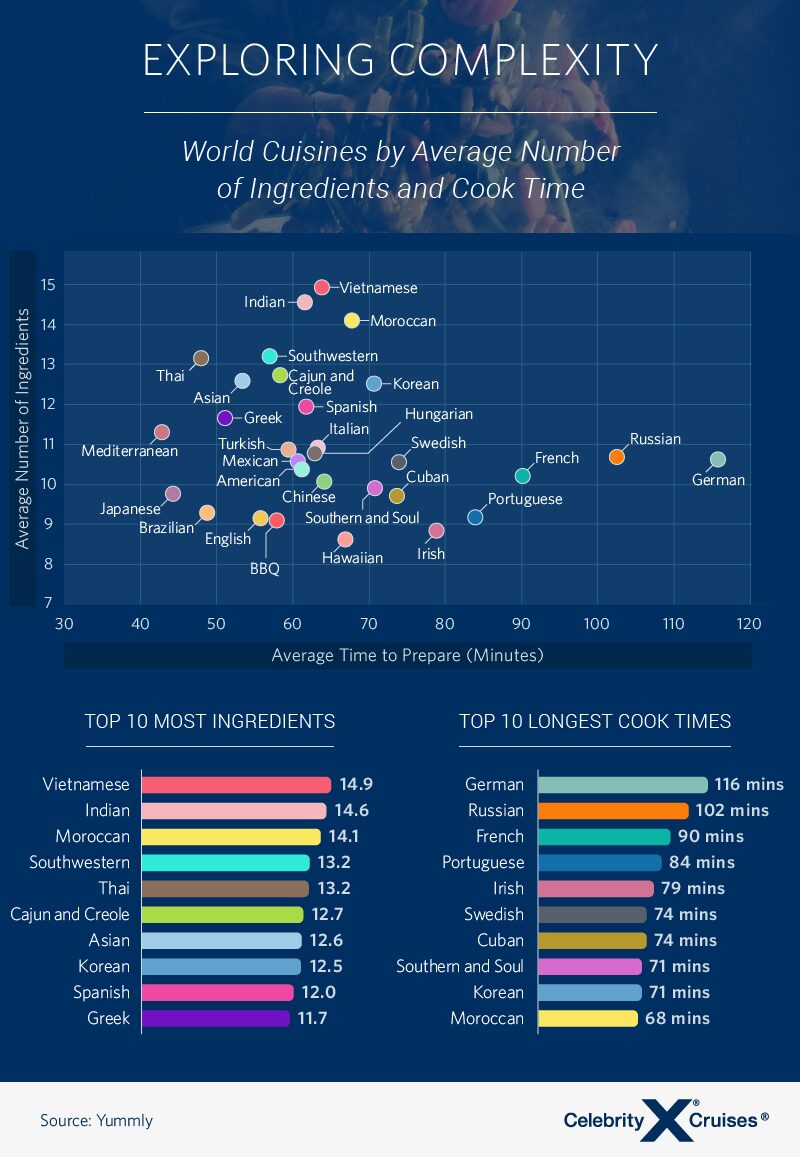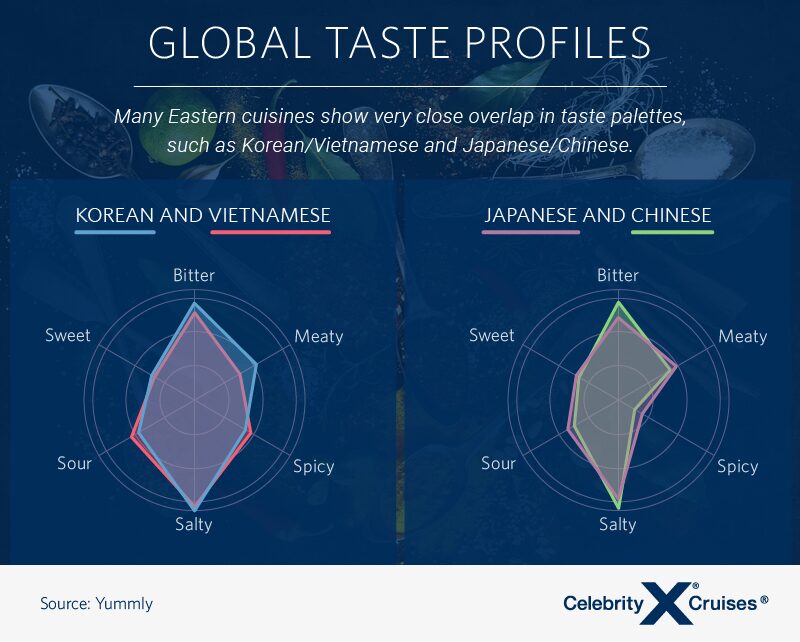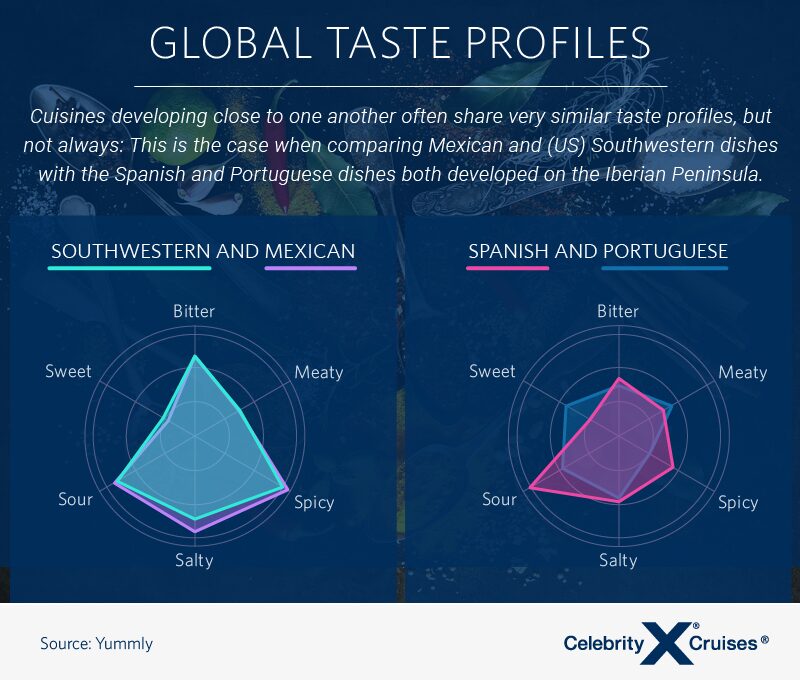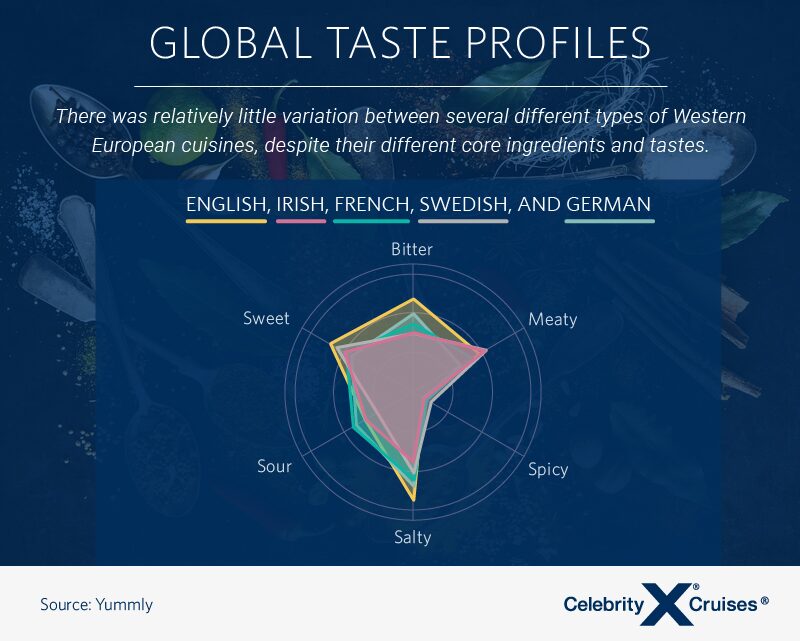One of the most distinctive features of a country is its cuisine. Regional flavors and local ingredients, nutritional value, and the complexity of recipes and preparation are the building blocks that make these global cuisines what they are. And while many cultures have unique customs when it comes to food and even how they eat, regions around the world do share some food-related denominators such as ingredients, preparation, nutrients, tastes, textures, and color.
So what are these links and differences between various world cuisines? Let's take a closer look.
MVP Ingredients

You can almost always tell what culture a certain recipe originates from by its main ingredients. You're most likely to see things like pasta, tomatoes, and parmesan cheese in Italian dishes, olives, lamb, and feta cheese in Greek recipes, and rice, black beans, and cilantro in Latin cooking. While there are plenty of differences when it comes to regional food, there is actually much more cultural overlap regarding staple ingredients.
Take salt, for instance. You can confidently assume that salt is found in nearly every kitchen, household, and country. This staple ingredient was used in 55% of recipes from all over the world and can be paired with pretty much everything. Additional staple ingredients include black pepper, garlic, olive oil, and butter.
When we look at specific cuisines, however, we can see specific similarities and differences. Asian cuisine, for example, includes various cultures such as Chinese, Japanese, Korean, Thai, and Vietnamese.
While these five cultures have quite a few ingredients in common, there are some notable exceptions. Soy sauce was the top ingredient among all Asian cuisines; however, although it was found in over half of Chinese, Japanese, and Korean dishes, soy sauce only came into play in about 20% of Thai and Vietnamese recipes. Instead, those two cuisines' most-used ingredient was fish sauce.
Cooking Complexities

Some cultures require multiple ingredients that can be hard to find, difficult to work with, or just downright unfamiliar. We discovered some of the most complex recipes were found in Vietnamese, Indian, and Moroccan cooking. These cuisines all typically used around 14 to 15 ingredients in a single recipe.
One of the most well-known Vietnamese dishes is pho (pronounced "fuh"). An authentic recipe uses about 16 ingredients.
It's not just ingredients that can lead to complexities in a recipe. Preparation time can add to this as well. Our research found that German cooking averaged the longest cooking time at 116 minutes, with Russian cuisine coming in with 102 minutes and French at 90 minutes.
A traditional recipe for German bread rolls can take more than three hours, while a classic Russian borscht recipe can take over five hours.
Recipe Repeats

This graphic represents similarities between cuisines (the closeness of bubbles) and how many recipes are commonly available online (the size of bubbles). Hover over a cuisine to see which other cuisines are most similar in terms of ingredients.
There are many inspirations for recipes – a lot of which may have to do with where a particular culture is located. There are interesting similarities between Eastern and Western European countries. For instance, Spanish, Greek, and Mediterranean cuisines use a lot of the same ingredients. The countries where these cuisines are found are relatively close to one another.
As a more unique cuisine, Hawaiian dishes don't have many close food partners, yet it has elements of cuisine from several Asian traditions, as well as Spanish and Portuguese recipes. In addition to cultural influences, Hawaii's latitude makes it comparable to cities like Hanoi and Hong Kong, meaning some ingredients may be similar due to the climate, temperature, and terrain.
The cuisines that are most influenced by other cuisines, such as southwestern and barbecue, are shown toward the middle of the graphic, as they utilize ingredients derived from a myriad of cultures. American fare is a prime example of this, as it is often referred to as a "melting pot" when it comes to food.
Unique Eats

We've seen how many ingredients have found their way into multiple cuisines.
However, certain ingredients undoubtedly suggest certain regions. Take feta cheese, for example. While this ingredient is used throughout the world, it is most associated with Greece. It's the main ingredient in traditional Greek dishes such as spanakopita and tirokafteri.
Plantains are another culture-specific ingredient, most commonly found in Brazil and Mexico. The plantain needs a certain type of environment to flourish and grows best in low-lying farmlands that are moisture-rich and humid. They can be prepared either sweet (maduras) or savory (tostones).
An interesting ingredient that is found in Western European countries, specifically Sweden, Germany, and France, is marzipan. This "candy-like mixture" is made from ground almonds and used in many confections, especially around the holidays when desserts like German stollen cake are popular. Its thick, dough-like texture makes it ideal for molding into various shapes, and it can even be used to make table adornments.
Trending Tastes
Taste palates are also prominent features of cultural cuisines. One culture may rely heavily on spice, while another may stay as far away from heat as possible. And one culture may like its food salty, while another is more interested in sweet flavors.

Korean, Vietnamese, Chinese, and Japanese food all lean more toward saltiness and bitterness. However, Korean and Vietnamese food are much more similar to each other than they are to Chinese and Japanese food, which are alike in their own right.

Regional proximity is not always a telltale sign of cuisines' likeness, however. In some cases, proximity certainly predicts a close alignment of flavor palettes, such as in Mexican and U.S. southwestern-style cooking. While Spanish and Portuguese dishes are from the same area, their flavor profiles are not very alike at all.

The taste preferences for Western European countries seem to align across the board, despite each country having distinctive flavor profiles and ingredients. The French enjoy coq au vin with deep flavors of braised chicken and burgundy wine, the English indulge in heavy dishes of fried fish and chips and cottage pie. The Irish sit back with a plate full of bangers and mash, the Germans have their schnitzel, and the Swedish have their classic meatballs. While all of these dishes are different, there is one thing that remains the same: Meaty and salty palate preferences prevail.

Mashup cuisines such as Hawaiian and Cajun & Creole both have influences from disparate culinary traditions, and as such they are two of the least-similar cuisines examined in this study. Taste preferences are all over the map, similar to their influence. While Hawaiian and Cajun and Creole food tend to appreciate sourness, the similarities end there.
The Skinny on Nutrition

We've explored ingredients, flavors, and taste preferences, but there is one last element to explore: nutritional value.
Asian cuisine, for example, seems to rely less on protein-rich ingredients. This is true for Chinese, Thai, Japanese, Korean, and Vietnamese recipes. All of these cuisines, however, are comprised of dishes that are very high in fat, with carbohydrates not falling far behind. When thinking about the key ingredients that make up Asian cooking, you might assume soy sauce, sesame oil, rice, and noodles. All of these things are low in protein but do contain significant carbohydrates and fats. In fact, most world cuisines seem to incorporate high-fat content.
Many of these high-fat ingredients could be considered healthy fats, especially within Mediterranean cooking where an emphasis is placed on olive oils, nuts, and seeds. Ingredients that are high in healthy fat do have a lot of nutritional benefits. Fat provides a major source of energy for the body, and it also helps the body absorb specific fat-soluble vitamins and antioxidants. Fat gives structure to your body's cells, and certain fats are essential for heart, brain, and nerve function. Fat also has more calories than protein and carbohydrates, so it also keeps you full longer and is usually more flavorful, which means you probably only need a small amount to satisfy your palate.
Getting a Taste for Travel
No matter where in the world you are, food always brings people together. In fact, the cultural overlap between regions, countries, and styles of cooking allows us to see just how much people have in common, even if they don't share the same ZIP code. Our data showed that, even for all the differences in tastes and palettes out in the world, there are some things about food that are truly universal. Traveling abroad is about discovering new places and seeking out new experiences. Whether you’re just trying a few new things or planning an entire culinary journey, exploring new foods while traveling is one of the easiest (and most delicious!) ways to get in touch with your surroundings.
If you’re looking to see the world and brought an appetite with you, then we’ve got you covered. At Celebrity Cruises, we provide an unparalleled dining experience, for our guests, whether you’re in the mood for sushi, seafood, Italian, or veggie fare. chefs and can cover whatever you’re in the mood for, be it something new and exotic or an old favorite from childhood. Best of all? Celebrity Cruises offers 24-hour in-stateroom dining, so you never have to wait for a bite of your favorites.
Ready to try something new and exotic? Visit CelebrityCruises.com to book your next adventure.
Methodology
All recipes, cuisine types, ingredients, and nutritional data were sourced from Yummly, an online and mobile recipe aggregator. Yummly provides over 30 distinctive regional cuisine types that were used as the categorization basis for this project, and all other nutritional information was used directly from the site without modification. We used a tf-idf (term frequency and inverse document frequency) statistic as the basis for discovering similarities between cuisine types, essentially computing the degree of commonality and overlap among ingredients across thousands of recipes. Although Yummly is one of the most comprehensive recipe sources on the web, it nonetheless lacks comprehensive categories for all world cuisines, and thus some cuisine types are either amalgams of several different subtypes (such as Asian), and others are not as fully represented in the dataset.
Fair Use Statement
Cuisines are meant for sharing, and food is meant to bring people together. If you enjoyed our exploration of how cuisines connect around the world, you are free to use the visuals or editorial from this page for any noncommercial purposes. Please include a link back to this page to ensure our creators get proper credit for their work.
